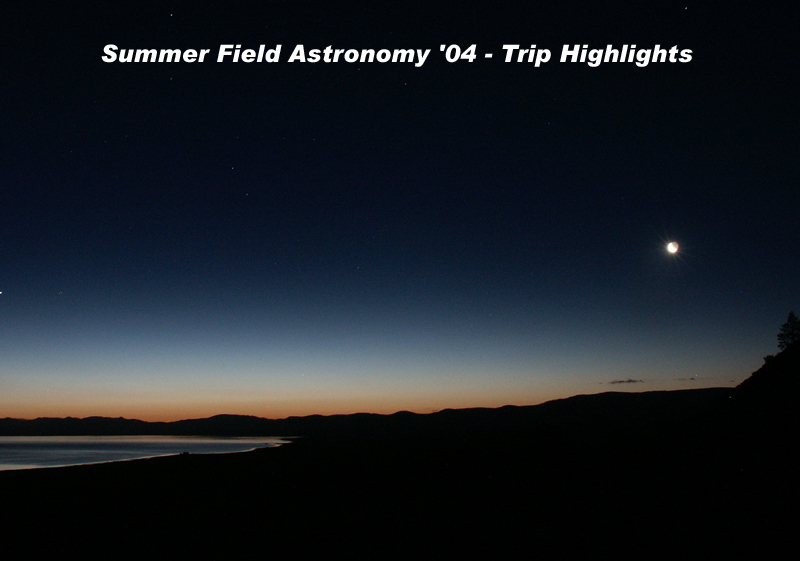

I arrived on Sunday afternoon. Monday at dawn was beautiful, with the waning cresent moon and stars shining above this prehistoric place.
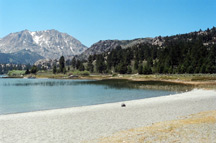 Our
crew arrived at Gull Loop in Oh Ridge campground on the shores of June Lake
throughout the afternoon
Our
crew arrived at Gull Loop in Oh Ridge campground on the shores of June Lake
throughout the afternoon 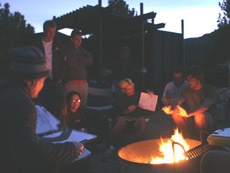 and
early evening. Some lingering clouds from the afternoon thunderstorms slowed
our observing in the evening, but we still got nice views of the Ring Nebula,
M13, and the Whirlpool galaxy via the CCD camera/lap top computer set up manned
by Eric. This followed my campfire lecture on star formation.
and
early evening. Some lingering clouds from the afternoon thunderstorms slowed
our observing in the evening, but we still got nice views of the Ring Nebula,
M13, and the Whirlpool galaxy via the CCD camera/lap top computer set up manned
by Eric. This followed my campfire lecture on star formation.
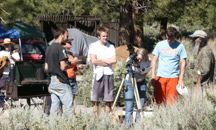 After
breakfast I gave a talk on the sun. Karl brought along the H-alpha solar telescope
from De Anza College; showing leaping prominences on the edge of the sun. There
were several sunspot groups as well, with bright plages nearby.
After
breakfast I gave a talk on the sun. Karl brought along the H-alpha solar telescope
from De Anza College; showing leaping prominences on the edge of the sun. There
were several sunspot groups as well, with bright plages nearby.
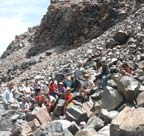 We
began our planetary science field studies with a drive south.
We
began our planetary science field studies with a drive south.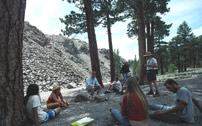 First stop was Obsidian Dome, a massive formation of black and red volcanic
glass formed just a few hundred years ago. Obsidian, a grainless glass rock
formed when silicon-rich lava solidifies
First stop was Obsidian Dome, a massive formation of black and red volcanic
glass formed just a few hundred years ago. Obsidian, a grainless glass rock
formed when silicon-rich lava solidifies 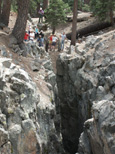 rapidly
after exiting a volcano, is found here mixed with pumice and a bit of rhyolite.
This group photo at left shows our crew; left to right are: me, Kevin, Nelson,
Emily, Eric, Garth, Maria, Doug, Joe, Chris, Tristana, Kelly, Karl, Nelson S.,
Rick, Kirk, and Brendan. Out of the picture are Ken and Nathan. At right I'm
explaining why the rocks at are feet are such a bizarre mixture of types and
origins.
rapidly
after exiting a volcano, is found here mixed with pumice and a bit of rhyolite.
This group photo at left shows our crew; left to right are: me, Kevin, Nelson,
Emily, Eric, Garth, Maria, Doug, Joe, Chris, Tristana, Kelly, Karl, Nelson S.,
Rick, Kirk, and Brendan. Out of the picture are Ken and Nathan. At right I'm
explaining why the rocks at are feet are such a bizarre mixture of types and
origins.
Next stop was "Earthquake Fault" just north of Mammoth Lakes. It's actually a long deep crack caused by volcanic dome formation which raised and cracked the earth's crust here.
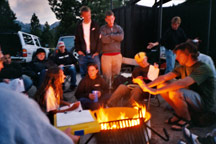 The
evening campfire lecture was on stellar evolution and the formation of white
dwarfs, neutron stars, and black holes. Clear skies this night brought out the10"
LX200 for rapid-fire computer controlled pointing to planetary nebulae, galaxies,
globular clusters, open clusters, Comet Q4 NEAT, and other wonders of the summer
sky. Kirk brought his 12.5" Dob, and Eric had his CCD camera linked to
his 6" and laptop (with LONG extension cords to the bathrooms) to add some
real time astrophotos of these objects.
The
evening campfire lecture was on stellar evolution and the formation of white
dwarfs, neutron stars, and black holes. Clear skies this night brought out the10"
LX200 for rapid-fire computer controlled pointing to planetary nebulae, galaxies,
globular clusters, open clusters, Comet Q4 NEAT, and other wonders of the summer
sky. Kirk brought his 12.5" Dob, and Eric had his CCD camera linked to
his 6" and laptop (with LONG extension cords to the bathrooms) to add some
real time astrophotos of these objects.
 After
a scrumptious breakfast of my fresh
After
a scrumptious breakfast of my fresh 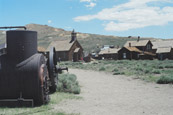 French
crepes, fruit, and yogurt, today's agenda was exploring the geology north of
Mono Lake. First stop was the ghost town of Bodie, where we discussed the formation
of heavy elements in stars and how some can end up in veins in the crust, followed
by compression and stretching processes and the formation of the Basin and Range
province in which Bodie is situated.
French
crepes, fruit, and yogurt, today's agenda was exploring the geology north of
Mono Lake. First stop was the ghost town of Bodie, where we discussed the formation
of heavy elements in stars and how some can end up in veins in the crust, followed
by compression and stretching processes and the formation of the Basin and Range
province in which Bodie is situated.  All
of this under the eaves of a 120 year old store straight out of the wild west.
Next we drove through Bridgeport and on to Buckeye Hot Springs.
All
of this under the eaves of a 120 year old store straight out of the wild west.
Next we drove through Bridgeport and on to Buckeye Hot Springs.  Here
we enjoyed natural hot showers as the hot springs emerges from the mountainside
and cascades over travertine down to cold Buckeye Creek.
Here
we enjoyed natural hot showers as the hot springs emerges from the mountainside
and cascades over travertine down to cold Buckeye Creek.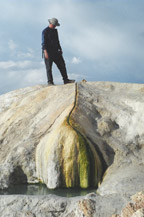 Last stop was Travertine Hot Springs just south of Bridgeport. At left, Kirk
examines the hot spring where it emerges from atop this travertine formation.
Last stop was Travertine Hot Springs just south of Bridgeport. At left, Kirk
examines the hot spring where it emerges from atop this travertine formation.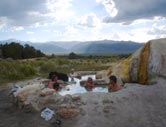 Back at camp, as we waited for our pasta to cook, Rick serenaded us with some
original folk songs while late afternoon thunderstorms created nice primary
and secondary rainbows.
Back at camp, as we waited for our pasta to cook, Rick serenaded us with some
original folk songs while late afternoon thunderstorms created nice primary
and secondary rainbows.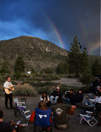
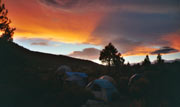
Late at night, skies cleared and Nelson and I did a one-hour count of June Lyrids. I was pleased to find that "my" meteor shower was still producing meteors, as we logged 13 sporadics and 7 June Lyrids between 1:50 and 2:50am PDT.
After a granola breakfast, we devoted the day to exploring Mono Lake and environs.
First stop was at Grant Lake Overlook,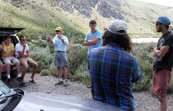 driving the perimeter of the June Lake caldera. We discussed the contrast between
the granitics along the western margins and the volcanics where we stood.
driving the perimeter of the June Lake caldera. We discussed the contrast between
the granitics along the western margins and the volcanics where we stood.  Next
we drove out to Lundy Creek to study the dark ash deposits from the Black Point
volcano. Volcanism-caused compression and folding created these twisted bands
at left.
Next
we drove out to Lundy Creek to study the dark ash deposits from the Black Point
volcano. Volcanism-caused compression and folding created these twisted bands
at left.
Then to Wilson Creek to search for rare stretch-pebble conglomerates and a
spectacular 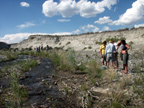 view
of lake bottom volcanic ash sediments topped by Black Point ash, with glacial
erratics of metamorphics and granitics on the creek floor (right). Next we studied
Mono Lake from the visitor center. The most interesting adventure was a hike
into Pahnum Crater to study contorted obsidian and pumice formations.
view
of lake bottom volcanic ash sediments topped by Black Point ash, with glacial
erratics of metamorphics and granitics on the creek floor (right). Next we studied
Mono Lake from the visitor center. The most interesting adventure was a hike
into Pahnum Crater to study contorted obsidian and pumice formations. 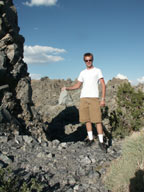 Nelson
holds a boulder of pumice at left. In the center photo, everyone's got their
own pretty rock of obsidian. Hey you guys, didn't you read the signs?? No collecting!
At right, I show flow-banded obsidian layered with pumice near the center of
the crater dome.
Nelson
holds a boulder of pumice at left. In the center photo, everyone's got their
own pretty rock of obsidian. Hey you guys, didn't you read the signs?? No collecting!
At right, I show flow-banded obsidian layered with pumice near the center of
the crater dome.


Above, we enjoyed the view of Mono Lake from the Visitors Center. Finally,
we drove to 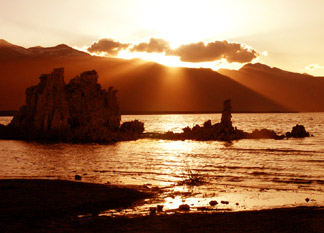 the
shores of Mono Lake at South Tufa and studied the interaction of
the
shores of Mono Lake at South Tufa and studied the interaction of 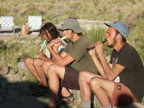 hot
springs and CO2-rich Mono Lake water to form the bizarre tufa towers, and drew
comparisons with the newly discovered springs on Mars. At right, Garth and Nelson's
kazoo jam session entertains us as I fix a dinner of beans, cheese, and chips
at Mono Lake. We ended with an optional evening photo session of the Milky Way
and star fields among the tufa formations. The black & white Milky Way shot
is actually from our previous Astro 30, in 1990, digitized from film. Note the
meteor in eastern Aquila.
hot
springs and CO2-rich Mono Lake water to form the bizarre tufa towers, and drew
comparisons with the newly discovered springs on Mars. At right, Garth and Nelson's
kazoo jam session entertains us as I fix a dinner of beans, cheese, and chips
at Mono Lake. We ended with an optional evening photo session of the Milky Way
and star fields among the tufa formations. The black & white Milky Way shot
is actually from our previous Astro 30, in 1990, digitized from film. Note the
meteor in eastern Aquila.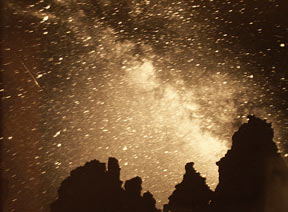
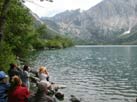 Our
final day began with my breakfast of fried curried potatoes and veges. Some
R&R time was spent swimming at the lake, followed by caravan'ing south to
Convict Lake where I lectured on the nature of the dark 100+ million year old
volcanics resting on the younger Sierra granitics and their origin via the Juan
de Fuca plate and deep sea trench subduction. This is one of the most dramatic
sites in the Sierras to study this. Note the incredibly folded deposits shown
on the glaciated face seen at left. Convict Lake is also dramatic for having
not one but 3 terminal moraines, showing the cyclic nature of the Ice Ages over
the past several million years.
Our
final day began with my breakfast of fried curried potatoes and veges. Some
R&R time was spent swimming at the lake, followed by caravan'ing south to
Convict Lake where I lectured on the nature of the dark 100+ million year old
volcanics resting on the younger Sierra granitics and their origin via the Juan
de Fuca plate and deep sea trench subduction. This is one of the most dramatic
sites in the Sierras to study this. Note the incredibly folded deposits shown
on the glaciated face seen at left. Convict Lake is also dramatic for having
not one but 3 terminal moraines, showing the cyclic nature of the Ice Ages over
the past several million years.
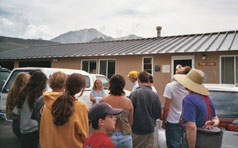 Afterwards,
we made a stop at the UC's Sierra Nevada Aquatic Research Laboratory below the
oldest Convict Lake moraine, where we got a brief tour and description of the
research projects being done by the scientists here.
Afterwards,
we made a stop at the UC's Sierra Nevada Aquatic Research Laboratory below the
oldest Convict Lake moraine, where we got a brief tour and description of the
research projects being done by the scientists here. 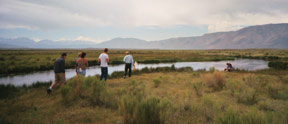 Then,
on to the Owens River for a picnic and mini-lecture on the sad history of how
L.A. bought the water of the Owens River Valley.
Then,
on to the Owens River for a picnic and mini-lecture on the sad history of how
L.A. bought the water of the Owens River Valley.
 "Imagine
the Universe as a Rock"...
"Imagine
the Universe as a Rock"... 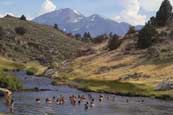 We
wrapped up the course lectures with my now famous talk on cosmology, multiple
universes, the "bigness" of the Big Bang (below!), and the nature
of life... all done as we soaked in the relaxingly warm primordial soup of Hot
Creek.
We
wrapped up the course lectures with my now famous talk on cosmology, multiple
universes, the "bigness" of the Big Bang (below!), and the nature
of life... all done as we soaked in the relaxingly warm primordial soup of Hot
Creek. 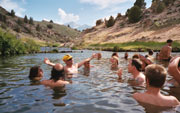
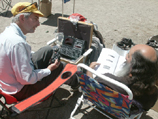 After
returning to camp, I fixed up a pasta dinner and then focused on preparing for
astrophotography. Below, Karl and I get familiar with our new STV video/CCD
camera before evening comes. This will provide autoguiding on our new Losmandy
GM8 mount, permitting up to half a dozen cameras to get guided pictures of the
skies.
After
returning to camp, I fixed up a pasta dinner and then focused on preparing for
astrophotography. Below, Karl and I get familiar with our new STV video/CCD
camera before evening comes. This will provide autoguiding on our new Losmandy
GM8 mount, permitting up to half a dozen cameras to get guided pictures of the
skies.
During the week, while I lectured and showed students the clusters, nebulae
and galaxies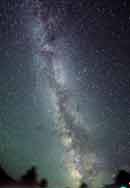
 through
the telescopes, Chris Angelos demonstrated astrophotography to the students
and captured some beautiful images. Here's some of his best... At right, this
incredible wide angle picture of our Galaxy's center, showing many of the star
formation and evolution subjects we studied this crystal clear night. Left is
the Lagoon Nebula and dark Nebulae of Sagittarius. And left is Comet Q4 NEAT,
receding from sun and earth, but still a nice 6th magnitude object with a blue
ion tail fanned above the yellow dust tail.
through
the telescopes, Chris Angelos demonstrated astrophotography to the students
and captured some beautiful images. Here's some of his best... At right, this
incredible wide angle picture of our Galaxy's center, showing many of the star
formation and evolution subjects we studied this crystal clear night. Left is
the Lagoon Nebula and dark Nebulae of Sagittarius. And left is Comet Q4 NEAT,
receding from sun and earth, but still a nice 6th magnitude object with a blue
ion tail fanned above the yellow dust tail.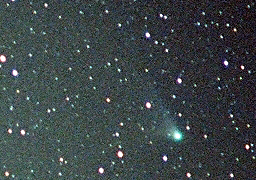 A colorful comet when combined with the green coma, below the bowl of the Big
Dipper.
A colorful comet when combined with the green coma, below the bowl of the Big
Dipper.
And finally, here is a colorful shot of the Veil Nebula in Cyguns, an ancient
supernova expanding shell.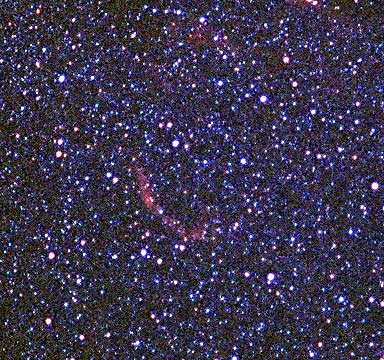
Eric Holmes was generous enough to show his telescope and astrophotography
gear to fellow students. 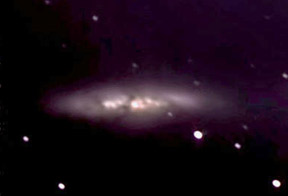 He
had a home-made CCD camera and 6" Newtonian and sent along these photos
of the irregular starburst galaxy M82, and the beautiful face-on spiral M51
(the Whirlpool). I did some post-processing in Photoshop; cropping and color
balance.
He
had a home-made CCD camera and 6" Newtonian and sent along these photos
of the irregular starburst galaxy M82, and the beautiful face-on spiral M51
(the Whirlpool). I did some post-processing in Photoshop; cropping and color
balance. 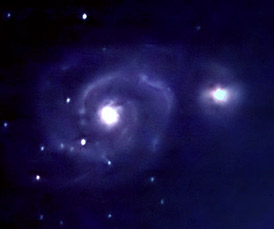
Saturday morning our gang said its farewells after a breakfast of fried potatoes and granola. Some of us did a final walk down to June Lake for a swim before heading out. It was a great trip! Let's hope we can schedule again for next summer.